From Redmond to India: high tech's global families
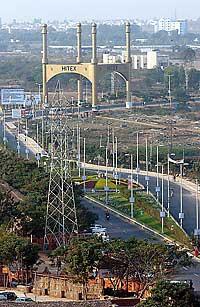
First in a four-day series
HYDERABAD, India — A lazy Saturday morning finds the Kumar family lounging at home on cushy den sofas from Costco. The girls play Nintendo. The parents sip tea, entertain guests and chat about their relatives.
It could be a weekend in Redmond, where the two girls were born, where Rajiv Kumar worked his way up to position and wealth at Microsoft, where he and his wife, Rekha, were among thousands of immigrants who had left home to work in the exploding American software industry in the 1990s.
But step outside their door on this Saturday. Exotic birds caw and hoot in the trees; chickens and cows meander on the road in front of the manicured lawn. The air smells of smoke from the campfires of squatters who live on vacant lots, next door to software executives and movie stars.
Last summer — 13 years after they traded family and tradition in their native India for jobs and possibilities in the United States — the Kumars completed the immigrant loop. They traded comfort and community in Redmond for culture and possibilities in India. Rajiv, 35, leads a team at Microsoft's outpost in a new frontier of software — a string of high-tech boomtowns across south India.
By making that shift, the Kumars have moved — twice — into the heart of the debate over the global economy.
They laugh now as they tell how shocked their relatives were — not that they left, in the first place, for America, but that, after achieving success, they returned.
"They don't get it," Rekha says, smiling over a cup of chai brought by her teenage servant.
" 'How come you came here?' " Rajiv recalls relatives saying. " 'People want to go there and you want to come here. Are you crazy or something?' "
Going global
Microsoft cuts costs, boosts sales through globalization
To understand the exodus of technology jobs overseas, the consequences of globalization and America's increasing interdependence with developing countries, there may be no better place to look than Microsoft.
Spurred by Chairman Bill Gates, the company is playing all sides of the globalization game in India: It is enlarging its global footprint by hiring thousands of workers at seven facilities throughout the country. It is pinching pennies and farming out small projects to low-priced Indian vendors. And it is selling buckets of software in the country.
Meanwhile, the company's rate of growth in the Seattle area has slowed dramatically.
Gates and other executives insist Microsoft will keep the bulk of its work at its headquarters campus in Redmond. But as manufacturing, agriculture and other traditional jobs move offshore, the shift of highly skilled, highly paid, high-tech jobs to overseas workers can be especially unnerving to some Americans.
Critics of globalization argue that outsourcing is now a threat to U.S. workers at the highest level of the employment food chain.
Just four years ago, U.S. tech workers commanded six-figure salaries, stock options and on-the-job perks such as foosball tables and free massages.
But as tech hubs such as Seattle and the Silicon Valley were booming, the rest of the world was running hard to catch up, aided by the very technology the U.S. tech industry produced. With fast Internet connections, world-class engineers in Hyderabad, Budapest or Manila could sell software and services from anywhere — and often at less cost.
At the same time, nearly a million higher- and lower-end tech jobs were lost in the United States from 2001 through 2003. This year, the situation improved as the economy did, but not for all professions. In the first three months, there were more jobs for software engineers, but the unemployment rate for computer scientists, systems analysts and programmers reached record highs, according to the Institute of Electrical and Electronics Engineers.
As a world tech leader, Microsoft has capitalized on those volatile changes, hiring workers from overseas when it couldn't find enough at home, shipping work back overseas when it could be done more cheaply there.
Rajiv Kumar was starting his career just as that wave of change was building. To understand how the shifting fortunes of the technology industry play out for individuals, his young family provides a telling example.
The Kumars' journey was not inspired by politics or trade policies. They traveled around the world for the same reasons immigrants have always given: economic opportunity, and the prospect of a better future for their daughters, Eshita and Sneha, now 9 and 6.
"I really want my kids to have the best of both worlds," Rajiv said last summer as he prepared to leave Redmond. "Because the world is becoming more global, for them to think globally and think of this country [the U.S.] and India as their home countries is a great feeling to have."
A long climb
First-class education helped pave the Kumars' way
Rajiv Kumar was born in 1968 in a small farming village 900 miles from Hyderabad, in the northern India state of Bihar. His father taught high school. For most of his childhood, his parents couldn't afford electricity. They still have no running water.
A child who didn't sit in a car until he was almost a teenager, Rajiv found it especially hard last year to sell his beloved Mercedes E320 sedan before he moved back to India. Now he drives a more modest Toyota Qualis SUV that doesn't stand out as much in a nation where the average person lives on less than $500 a year.
Raised amid a caste system that he opposed, Rajiv dropped his family's surname — Jayaswal, which identified him as of the business class. Now, buffered by the security of career, he has given his daughters the name to carry forward.
Rajiv tells his story in lightly accented English and weaves in funny anecdotes and gentle observations on current affairs. He is pleased with improving diplomatic relations between India and the U.S. — "that is a good thing for the whole world — the largest democracy and the most efficient democracy coming together finally" — and intrigued by technology's role in those changes.
He reveals an evangelical streak, a strong sense of Hindu spirituality (he spends about an hour every morning and night meditating in a prayer room), a passion for family and for work, and a belief Microsoft is making the world a better place by creating products that simplify people's lives.
Rajiv spent his teens waking at 4:30 a.m. to study before school. When formal classes were over for the day, he worked into the evening with a tutor. For his last two years of high school, he traveled five hours by train to a boarding school in Calcutta (now called Kolkatta).
He was smart enough, and worked hard enough, to be among the few admitted to the Indian Institute of Technology (IIT), a vaunted network of seven colleges modeled after the Massachusetts Institute of Technology. Even before India won independence from England in 1947, its leaders banked the nation's future on an education system that could produce top-notch technical experts; IIT was its most significant consequence.
Rajiv entered IIT's Roorkee campus, near New Delhi, in 1986 — the same year Microsoft started selling stock to the public. Personal computers were about to revolutionize the business world, and the tech industry was beginning its phenomenal growth spurt.
But opportunities were scarce in India, where the economy was largely closed to foreign investment and the bureaucracy made it difficult to import the computers that were a catalyst elsewhere.
Rajiv graduated into a world on the brink of a high-tech explosion. India's economy remained relatively closed; its future as a software giant was little more than hope and gamble. But in the U.S., the tech boom was well under way and hungry for workers. Well-trained Indian immigrants were a hot commodity as companies sought specialists who could build, install and operate the systems running those companies.
Rajiv waded into that new world armed with a state-of-the-art education — and a fiancée: Rekha Singhal was an IIT classmate, assigned to be Rajiv's lab partner by alphabetical circumstance.
They immigrated to the U.S. to attend graduate school at the University of Texas. Rekha remembers thinking that Austin was not so different from India — hot and dry. A year later they made a trip back to India and married in a traditional ceremony in Meerut, Rekha's hometown near Delhi.
Around that time, Microsoft was beginning a decade of virtually unstoppable growth. Emigration from India to the U.S. was reaching unprecedented levels.
From 1990 to 2000, the number of "Asian Indians" living in the U.S. more than doubled, from about 815,500 to nearly 1.7 million, according to the Census Bureau. In King County, the number of Asian Indians now outnumbers Native Americans — 17,353 to 14,235 — according to a 2002 census report.
Rajiv and Rekha moved to Redmond in 1992. Both had finished their master's degrees and were studying for Ph.D.s when Microsoft hired Rajiv.
As Microsoft grew, so did Rajiv's career. He helped build components of Windows, then helped develop technology designed to help programmers. Later he worked on business-software products, led development teams and ran a product group.
Rekha worked in software engineering, first at Wall Data in Kirkland, then at Microsoft as a contract employee.
The couple bought a modest split-level house on Education Hill in Redmond, which they still own. Their daughters were born, and Rekha chose to stay home to raise them. They settled in, joining a community of professional immigrants who brought a cosmopolitan feel to suburbs such as Redmond, where the senior center is more likely to hold classes in Hindu dance than in square dancing, and where the girls attended Hindi language school and, like many other suburban kids, played soccer.
Returning home
Indian culture, values figured in couple's decision
When Rajiv and Rekha came to the U.S. in 1990, they brought their belongings in two suitcases. When they returned to India last year, they packed two shipping containers.
During that extended round trip, Rajiv rode a wave of countrymen who introduced U.S. companies to the know-how of Indian programmers — and then persuaded their employers to establish a beachhead in the nascent technology industry back in India.
Rajiv is one of about 25 Indian-born Microsoft employees who worked at Redmond and moved to Hyderabad. Microsoft opened its India Development Center in the city in 1998; two years ago, Gates announced the company would double the size of the center to 500 employees. Early next year the company plans to move from rented space into its own building, the first on a 42-acre campus it is developing on the outskirts of Hyderabad.
To decide if they should join the reverse migration, the Kumars made two lists. One outlined reasons to stay in Seattle: friends and their home in Redmond topped it. Move back? Family, and the chance to expose Eshita and Sneha to Indian culture and values.
"We stayed there 21 years, then came here for [about] 10 years in this country, so we could see East and West, good things in both the countries," Rajiv said from his Redmond home last August. "India is good in spirituality and the U.S. is good for material advancement, so now we know the balance.
"The same kind of thing we want to give to our kids. If they want to go back in the future, they will now have an option to at some point. We are lucky that we are taking the good things from both places."
The tug to ground her daughters in family values was especially strong for Rekha, 34, who grew up in a tradition where parents sacrifice all for children.
Her father was a businessman who transformed his hard work into schools and tutors for his three children. Her mother wanted to be a doctor but grew up in a time when women married after high school or risked being branded barren. She cooked, cleaned and waited on her children so they could concentrate on their studies. When Rekha's sister went to medical school, her mother studied her books; she still reads medical texts in her spare time.
"In India, you won't eat but give food to your kids — do anything for your kids, to feed them, raise them, give them a good education, no matter what it takes," Rekha says.
Gazelles and lions
Poverty in India provides lesson in value of education
The Kumars now send their daughters to Oakridge International Academy, a private school popular with managers at the multinational companies swarming to Hyderabad. The school's Web site boasts that it "prepares children to be globally competent citizens with an international understanding and futuristic outlook."
Morning draws a parade of chauffeured Toyota SUVs and the occasional Mercedes sedan to the school gate to deliver a small army of children — girls in khaki dresses, boys in khaki pants and plaid shirts. They begin each day standing at attention on a grassy parade ground, rice paddies in the distance, as the principal delivers a prayer and a speech.
Prayers over, the students troop through the school's marble lobby to class, past a poster the principal hung earlier this year. It reminds them this:
"Every morning in Africa a gazelle wakes up. It knows that it must run faster than the fastest lion or it will be killed.
"Every morning a lion wakes up. It knows that it must outrun the slowest gazelle or it will starve to death.
"It doesn't matter whether you are a lion or a gazelle: When the sun comes up, you'd better be running."
Strong words for elementary-school children. But words that Rajiv understands. Like many successful immigrants, he knows his American-born children will have more options and, likely, better lives. But, without the pressure he faced to study his way out of poverty, will they have the same work ethic and values?
By taking Eshita and Sneha to India, the Kumars are surrounding them with family and exposing them to what could have been. India's stubborn and pervasive poverty, just a few feet outside their front door, is stark testimony to what can happen to those who fail to elevate themselves through school.
"That's why we always make sure we go to my village, where it's a small town, and we go and meet our relatives," Rajiv says. "So that they see that it's not only living this luxurious life and five-star hotels, but there's this other part of life also and it's pretty hard. The good part is they have been able to mix in both kinds of society very easily."
Even so, Rajiv wonders if his American daughters will inherit his drive: "We just have to give them some motivation to go to school and do good in school."
"In India, they'll go and see better," his wife says, nodding. "If you want to get better, you have to work harder."
Mixture of old and new
Family's life merges traditional East, modern West
As much as time in America changed the Kumars, so are they now changing India. And their immersion into some old-world ways can sometimes be at odds with new-world sensibilities.
At Christmastime, Rekha dressed as Santa Claus and went to the girls' school, where she gave out chocolates as the children sang "Jingle Bells." It was her way of introducing other rituals in a country predominantly Hindu and Muslim. Some of the younger children shook with excitement, thinking she was real, and begged her to come back again.
The costume also fooled the dance teacher who gives private lessons at the Kumars' home. The teacher didn't recognize Rekha behind the beard. When Rekha reached out to give her a hug, the teacher ran away in fear.
The family still laughs at the story.
But others aren't as funny. Rekha has struggled to submit to traditional Indian authority figures — especially doctors. She can always run questions past her sister, a surgeon in Chicago, but the expectation of passivity irks her.
"After 12 years in the U.S., I question everything," she says.
She had thought about resuming her career; there are servants in India to help with the cooking and housework. Instead, she found herself busy managing and training the staff.
Servants live in two apartments on the basement level of the Kumars' house. The arrangement is fairly standard for managers and Westerners working in India.
Having the help gives the Kumars more time to spend with their children and each other, and Rekha is more casual and generous with her servants than a traditional Indian housewife might be. She leaves the kitchen unlocked and lets them help themselves to food.
The Kumars rented their house from another Microsoft employee who returned to Redmond. It is nestled among the homes of executives, tech engineers and movie stars in Jubilee Hills, a neighborhood equivalent to Medina on Seattle's Eastside; the tile roof and pale stucco exterior would be at home in Bellevue or Palo Alto.
Home is a blend of the traditional East and the modern West. Rajiv corresponds with co-workers at Redmond via a wireless networking system, while the girls take Indian dance lessons on a vast marble-floored landing. One of the five bedrooms is reserved for prayer and meditation. Three hold furnishings from Costco brought from the U.S.; relatives were startled at how high the beds sit off the floor. Only the guest bedroom has a traditional Indian bed with its rounded corners and low, textured frame.
The house is full of keepsakes from life in Redmond, including a plaque thanking the Kumars for performing an Indian dance at the Seattle Folklife Festival, a photo of the family riding a ferry and a painting of an evergreen forest, with a snowy mountain in the background.
The American-born girls are U.S. citizens, but Rajiv and Rekha are still waiting for their applications to be approved. Meanwhile, they consider themselves to be both American and Indian. "We are international," Rekha says. "I'm not attached to one place — wherever life takes us."
Tea, not Coke
Microsoft in India has familiar trappings — with some twists
The curlicue script on the sign in the ninth-floor lobby of the Gateway Tower in Hyderabad's Hitec City office park announces MICROSOFT in Telegu, the dialect of the surrounding state.
Inside, the work spaces look much like those at the company's older campus buildings in Redmond and employees speak English. But religious icons grace the lunchroom, and conference rooms draw workers who snatch a few minutes to watch cricket on the big-screen TVs.
There is a gym, and break rooms with pingpong tables and snacks — another echo of Redmond. But the workers lean toward tea and fried munchies rather than the Coca-Cola and popcorn served in Redmond. And women dressed in saris deliver the snacks.
Some 450 Microsoft employees work here and at a nearby building where programmers support the company's human-resources department and develop, test and manage network systems the company uses in-house. Microsoft's cost per employee in India is about half its cost in the U.S., and even Rajiv took a pay cut when he relocated.
That presence is sure to expand: Microsoft recently acquired options on 42 acres for the new campus, scheduled to open early next year. Additional transfers from Redmond are also likely.
"More and more people who are in this country [the U.S.] of Indian origin are thinking, 'Hey, should I be in India?' " said S. Somasegar, the Microsoft vice president in Redmond overseeing the Hyderabad center. "It varies from person to person, but some people say, 'Hey, I have kids now, maybe for the next four years I ought to be in India.' ... Or it could be, 'My parents are getting old, let me spend a few years with parents and come back.' "
Microsoft says most development work will remain in Redmond, where it employs about 27,000 people. But the new Hyderabad campus could accommodate thousands, too. And expansion here has been steady since a 1997 visit by Gates, who became excited about the local pool of skilled software developers.
The initial task of the company's India Development Center was to develop a way to connect Microsoft operating systems with the industrial-strength Unix systems commonly used in India then. The center then designed connectors to link Microsoft's Outlook with IBM systems and a software language for programmers familiar with Sun Microsystems' Java language.
Now Rajiv Kumar is building a development team to create products to run small- to medium-size businesses, a major market for the company. He hired 50 engineers, many from Indian subsidiaries of other U.S. tech companies. He started hiring more than a year ago, back in Redmond, and didn't finish until early this year. Competition for talent is stiff.
When he returned to India, Rajiv returned not only with the technical skills but with a distinct Microsoft management style. In a January meeting to introduce himself to members of his new team, there was none of the stiff decorum common at Indian companies. His presentation was friendly and personal, sprinkled with jokes. He encouraged engineers to establish buddies to support each other, and he promised bowling nights and other morale-building sessions.
Yet he made it clear that the team must have a vision and goals, and that its priority was to finish and ship products: "At the end of the day, if we are not shipping, nothing matters."
Then he delivered a motivational mantra that is well-known in Redmond:
"When you go to your neighbor's place and see that product being used, man, it's a satisfying experience. We are really helping people get better in what they do, or making their lives simpler."
His workers have to believe — and they have to work. Because their competition is around the world — and right next door.
Multinationals such as General Electric, Oracle and the London-based bank HSBC have offices nearby, as do Indian software companies such as Wipro and Tata Consulting Services.
Back in the United States, the debate rages about the pros and cons of a globalized, outsourced economy.
But in pockets of India, such as Hyderabad, that economy is already at work: A phalanx of highly skilled tech specialists are paid relatively little to develop, test, sell or support products that are in demand worldwide.
Concern is global, too
Fears about the new economy swirl in India, U.S.
Hyderabad is in one of the most progressive states in India, where the federal, state and municipal governments are carefully planning expansion, improving infrastructure and courting international trade. Wide, tree-lined boulevards lead from the airport into the city center and to the suburb that includes Microsoft's building, a new convention center and sports stadiums.
But just outside the mirrored windows and past the security gates, the other India takes over. Cows and barefoot children wander down the road, shanties dot the adjacent fields, and hawkers sell fruit, tea, fried snacks and packets of paan, an herbal equivalent to chewing tobacco.
The explosion of the tech industry isn't celebrated with universal fondness here.
During May's elections, voters ousted a prime minister who had aggressively promoted trade and economic growth. Some traditionalists oppose how multinationals are Westernizing their ancient, deeply religious culture. Others grumble that the only progress they can measure is in traffic jams and real-estate prices.
Against that backdrop, software companies seem like an anomaly. Their tiny share of the nation's economy, combined with the complicated political situation and the chaos and poverty of urban India, undermines the image of India as a monolithic threat to America's tech industry and economic recovery.
India's software and computer-services industry added 130,000 jobs in 2003 and employed about 650,000 people, of whom 250,000 were involved with the export of software and computer services, according to India's National Association of Software and Service Companies, or Nasscom.
Yet that's tiny compared with the U.S. industry, which last year had 5.7 million employees and lost about 250,000 jobs. And although India's high-tech industry has grown dramatically and its profile is high, India remains a relatively small player in information technology. Its share of all the money spent around the world on technology was still just 2.8 percent last year, according to Nasscom.
Still, the growing strength of India's tech center is an increasing concern for American tech workers, labor unions and some politicians. Some worry that jobs will go the way of manufacturing, where overseas competition contributed to the loss of 1.5 million U.S. jobs from 1992 to 2002, according to a February report by the U.S. Bureau of Labor Statistics.
"Almost everybody in the work force is looking over his or her shoulder, is not making a wage claim, is not asking for a raise, is scared out of his or her pants about the prospect of losing their job," said Tony Daley, research economist with the Communications Workers of America, during a news conference in April unveiling a Web site that tracks reports of jobs lost to outsourcing.
Daley's "Outsourcing Tracker" reports that about 240,000 tech jobs have been transferred overseas since 2000. But he says that number is more than conservative: "We predict the real figure to be well in excess of 1 million."
That conflicts with predictions by the U.S. Bureau of Labor Statistics, which say computer-systems design and related services will be one of the nation's 10 fastest-growing industries and add more than 600,000 jobs between 2002 and 2012.
Software publishing, the bureau predicts, will be the fastest-growing industry over the same period, with employment growing by 68 percent, or more than four times that projected for all industries combined.
But the agency's forecast warns that outsourcing could affect software and computer-services jobs. "Employment growth may be tempered somewhat as companies contract out more of the routine tasks to foreign countries, where labor costs are lower, in an attempt to remain competitive," says its 2004-2005 career guide issued in February.
Recurring free-trade debate
Rajiv sees issue as "competency, quality and better value"
Rajiv Kumar knows this debate from both sides. During a sunset walk around a lake near his house where Indian professionals come to jog after work — a place not unlike Seattle's Green Lake — he discusses history, economics and reality.
His bottom line: There is not much that can — or should — be done to stop the market forces that have moved his family halfway around the world and back.
He was just starting his career with Microsoft when the fierce debate erupted over NAFTA — the North American Free Trade Agreement. He listened to colleagues condemn it and harbored his own fears, fretting that "good things" would go to Mexico while unemployment and poverty would grow in the U.S.
"But that didn't happen," he says. "Because in the end you have to compete on competency, quality and better value."
The issue came up again five years ago, during a visit home to India. Rajiv's brother-in-law lamented new trade policies that opened India to more imports, including consumer goods such as razors and shampoo, and that threatened to kill off Indian industries.
Instead, Rajiv says, Indian consumers were introduced to higher quality products, and Indian companies improved their own goods in response. "And the funny part is Indian people, when they saw the quality, they started demanding it," he says.
What's more, Rajiv sees the impact reaching beyond the economy to India's democracy. In the years he was gone, Rajiv says, the Indian media have grown with the tech industry, bringing new scrutiny of the government.
"Finally, for the first time in India, they are talking about politicians having debates," he says. "Those things will help bubble up the right set of people who should run the country, rather than just physically powerful ones. That is good for the country."
Embracing their culture
A return to traditional markets, music and dance
Meanwhile, the Kumars are immersing themselves in Indian culture. On Saturdays, they often shop at the traditional farmers market, instead of a grocery store. On Sundays, they observe Hindu prayer and meditation rituals in the morning. Then musicians come to tutor Rajiv in the tabla, an Indian drum, and Rekha and Eshita in classical Indian song.
" The girls are learning Telegu, the dialect spoken in the Hyderabad region. But they still talk to their parents in English and to other Indians in Hindi, the official national language.
During the week, the girls study classical Indian dance. Friends and neighbors join them for the tutored classes, which are held on an upstairs landing that serves as a small dance floor.
A media room next door is crammed with high-end stereo equipment brought from the U.S. But the teacher ignores the technology and instead taps out the dance rhythm with a stick and a block of wood — a chanting human metronome calling out moves and pointers.
Back in Redmond, Rekha taught traditional dance to the children of Indian immigrants. But here the teacher is more advanced, and Rekha is learning the old steps along with her girls.
As they dance, their servant girl sits watching, partway up the staircase, a laundry basket in hand.
Brier Dudley: 206-515-5687 or bdudley@seattletimes.com
Ami Vitale is a freelance photographer working in India. Her e-mail address is ami@amivitale.com.




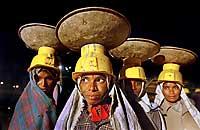
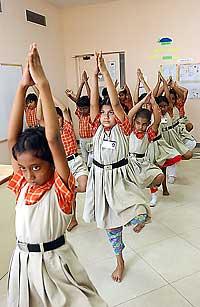



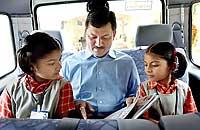
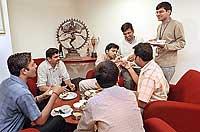





|
|
|